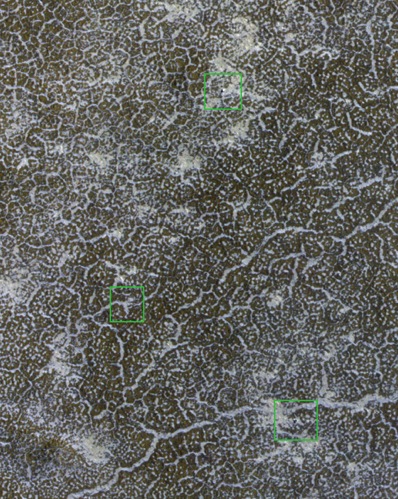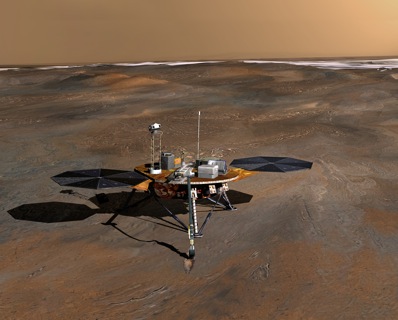
Will Phoenix rise
from the ice?
DR EMILY BALDWIN
ASTRONOMY NOW
Posted: 12 January 2010


From 18 January, NASA's Mars Odyssey orbiter will listen for possible radio transmissions sent by the Phoenix Mars Lander, which has been buried under ice throughout the harsh Martian winter.
Phoenix landed in the northern polar regions of Mars in May 2008 and continued to function two months past its warranty, until November 2008 when the falling levels of sunshine stopped operations. Since then Phoenix has endured autumn and winter, and is now emerging from the ice as spring gets a grip on the northern hemisphere.
 Phoenix (bottom) and its backshell (top) and heatshield (middle) are visible in this Mars Reconnaissance Orbiter image captured by the HiRISE camera on 6 January 2010. Carbon dioxide frost dominates the landscape. Image: NASA/JPL-Caltech/University of Arizona. Phoenix (bottom) and its backshell (top) and heatshield (middle) are visible in this Mars Reconnaissance Orbiter image captured by the HiRISE camera on 6 January 2010. Carbon dioxide frost dominates the landscape. Image: NASA/JPL-Caltech/University of Arizona.
Phoenix's hardware was not designed to survive such temperature extremes so it is extremely unlikely that there is any life left in the lander, but if systems are still operational, once enough energy falls onto the solar panels, it will try and communicate a radio transmission to any available Mars orbiters.
Mars Odyssey will pass over the Phoenix landing site ten times each day during three consecutive days of listening this month, with two longer listening campaigns in February and March, where Odyssey will also transmit radio signals that could be heard by Phoenix.
 Artist impression of Phoenix on the surface of Mars. Image: NASA. Artist impression of Phoenix on the surface of Mars. Image: NASA.
"We do not expect Phoenix to have survived, and therefore do not expect to hear from it," says Chad Edwards, chief telecommunications engineer for the Mars Exploration Program at NASA’s Jet Propulsion Laboratory. "However, if Phoenix is transmitting, Odyssey will hear it. We will perform a sufficient number of Odyssey contact attempts that if we don’t detect a transmission from Phoenix, we can have a high degree of confidence that the lander is not active.”
At present, the amount of sunshine falling on the Phoenix site is about the same as when the lander ceased communications on 2 November, 2008, with the Sun above the horizon about 17 hours each day. The listening will continue until the Sun is above the horizon for the full 24.7 hours of the Martian day.
 Phoenix struck gold early on in the mission, finding that ice exposed in a trench on sol 20 had sublimated into the atmosphere four sols later. Image: NASA/JPL-Caltech/University of Arizona/Texas A&M University. Phoenix struck gold early on in the mission, finding that ice exposed in a trench on sol 20 had sublimated into the atmosphere four sols later. Image: NASA/JPL-Caltech/University of Arizona/Texas A&M University.
Should Phoenix still be operational, Odyssey will attempt to gain information about the lander’s status, determining what capabilities it has in order to plan any further activities.
During its five months of studying the arctic site, Phoenix dug trenches a few centimetres deep to reveal ice that quickly sublimated away, and found soil chemistry and minerals that strongly suggested that this region had a warmer, wetter climate in the recent past. A surprising find was a chemical called perchlorate, which attracts water such as pulling humidity from the Martian air, or combining with water as a brine. The discovery was a tantalising step towards finding evidence for past life on Mars, since on Earth, microbes use perchlorate as food. Phoenix also returned the first confirmation of the presence of ice clouds at these latitudes, finding also that it snows, adding another piece to the puzzle of understanding how water vapour moves from the atmosphere to ice on the ground.
|



